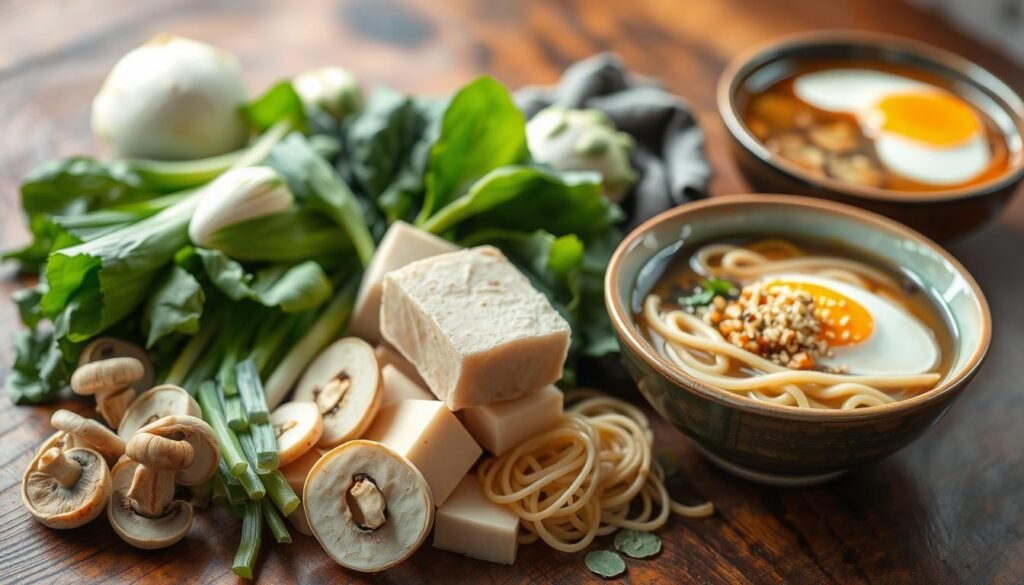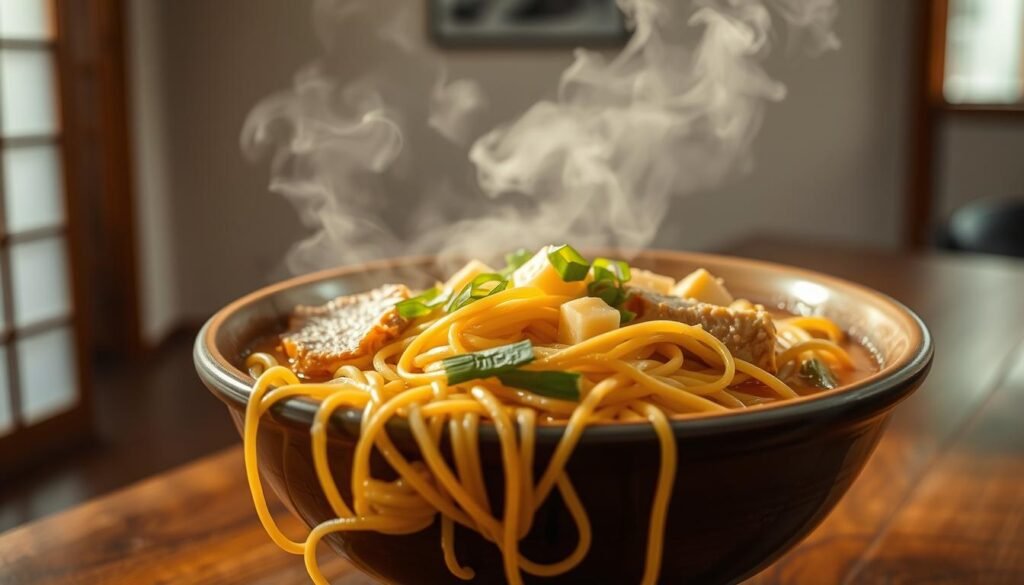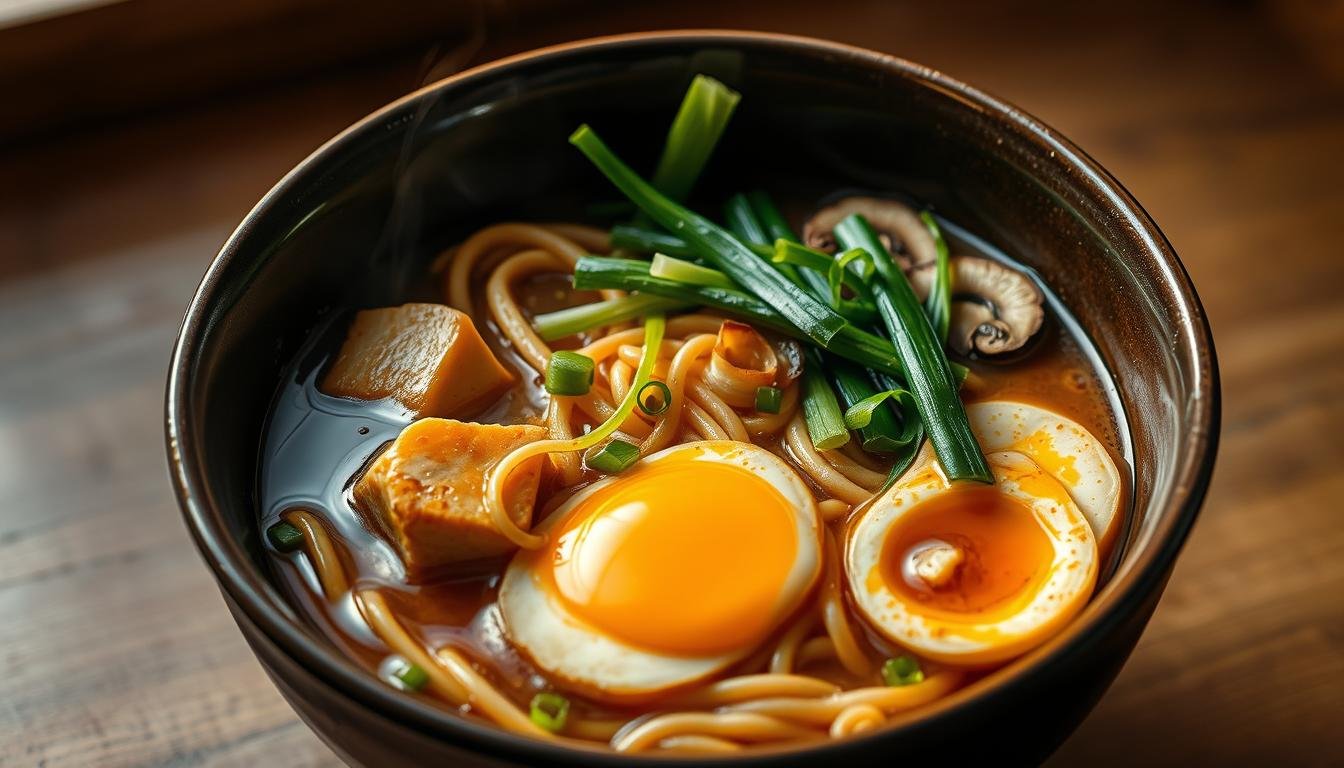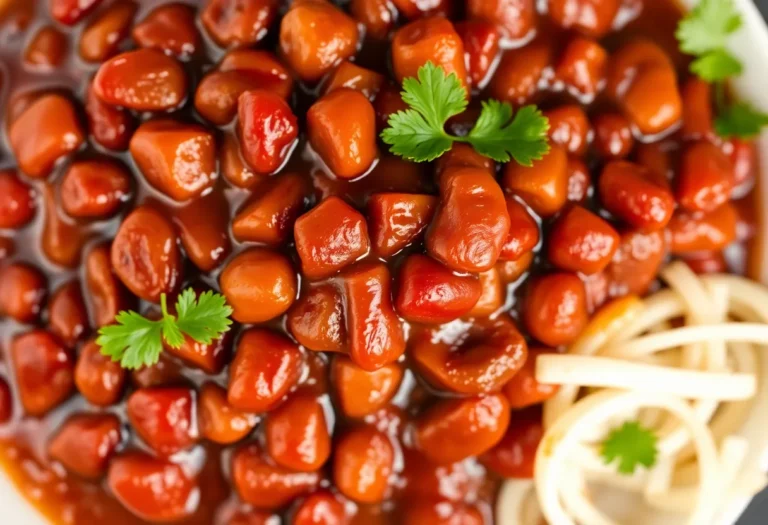Miso Ramen with Tofu
Ever wondered why miso ramen with tofu is so comforting? It’s more than a meal; it’s an experience. It turns simple ingredients into a mix of flavors and textures.
Explore the world of miso ramen with tofu. It blends traditional Japanese cooking with modern creativity. Whether you love food or just want to try something new, this dish will excite your taste buds. It’s a tasty vegetarian option that’s full of flavor.
The dish has a rich miso broth, smooth tofu, and just-right noodles. Each part tells a story of Japanese culture and cooking skill. Get ready to enjoy a dish that celebrates taste, health, and Japanese food traditions.
Key Takeaways
- Discover the authentic roots of miso ramen with tofu
- Learn how vegetarian ramen can be incredibly flavorful
- Understand the cultural significance of Japanese cuisine
- Explore the versatility of tofu in traditional dishes
- Uncover the secrets to creating a perfect miso broth
Quick Recomendation: Our blog is full of useful information to inspire you. If you are seeking a healthy way to prepare your meals, we recommend this Keto product
Understanding the Magic of Miso Ramen with Tofu
Explore the world of tofu noodle soup, a dish that turns simple ingredients into a warm hug. At its core is the miso broth, which adds a rich and complex flavor. This makes it a favorite among food lovers everywhere.
The magic starts with the miso base, packed with umami. This fermented soybean paste adds depth and warmth. Soft tofu then adds a silky texture, balancing the bold broth perfectly.
This dish is special because it comforts and nourishes. Each spoonful tells a story of Asian cooking traditions. The mix of tender tofu, savory broth, and noodles creates a meal that nourishes both body and soul.
Ramen fans and food enthusiasts are drawn to its global appeal. It’s versatile, loved by both home cooks and chefs. Whether you need warmth or a flavorful meal, tofu noodle soup with miso broth is the answer.
Essential Ingredients for Your Perfect Bowl

Starting an authentic miso ramen means picking the right ingredients. High-quality miso paste is key, as it shapes your dish’s flavor. White, red, or mixed miso can change your broth’s taste, adding unique umami flavors.
Tofu is a great plant-based protein for your ramen. Silken tofu is soft, while firm tofu is firmer. Choose organic tofu that cooks well and soaks up your broth’s flavors.
Noodles are vital for your ramen. Fresh ramen noodles are best for their authentic taste and texture. Wheat-based noodles match the miso’s deep flavors well. If fresh noodles are hard to find, good dried ones can also work.
Don’t overlook ingredients that add depth to your ramen. Kombu seaweed, dried shiitake mushrooms, and green onions enhance umami flavors. They turn a simple soup into a Japanese culinary masterpiece.
Crafting the Perfect Miso Broth Base

Making a great miso ramen with tofu begins with a rich broth. This broth is the heart of the dish, a key part of Asian comfort food. The secret is choosing the right miso paste and adding complex umami flavors.
Start by picking your miso paste wisely. White miso is mild and sweet, while red miso is deeper and more intense. Mixing different types can create a unique flavor that goes well with tofu.
To get those umami flavors, use a dashi base. Mix kombu (dried kelp) and bonito flakes for a savory start. Simmer them slowly to get all the flavor. Then, strain and add your chosen miso paste. Don’t boil the miso to keep its delicate flavors.
Add flavor boosters like roasted garlic, ginger, or sake. These will make your broth richer and more complex. The perfect broth is all about balance and patience.
Your aim is a broth that’s rich, aromatic, and full of depth. It should make your ramen a memorable experience that warms your body and soul.
Preparing and Seasoning Tofu for Ramen

To make tofu the star of your tofu noodle soup, start with the right kind. Choose firm or extra-firm tofu for the best texture. Pressing it removes excess moisture, making it absorb flavors better.
Press the tofu by wrapping it in clean towels and weighing it down for 15-20 minutes. This makes it firmer and better for your ramen’s broth. Cut it into cubes or rectangles for even cooking and a nice look.
Marinating is key to boosting tofu’s taste. Mix soy sauce, sesame oil, garlic, and ginger for a tasty marinade. Let the tofu soak in it for at least 30 minutes before cooking. You can fry, bake, or grill it for a crispy outside.
Try different seasonings like cornstarch for extra crispiness or spicy marinades. Treat tofu as the main event in your vegetarian ramen. It’s more than just a protein substitute.
Selecting and Cooking Your Ramen Noodles

Choosing the right noodles is key to making a true Japanese dish. Your ramen journey starts with knowing the different noodles in Japanese cuisine. Wheat-based noodles are the classic choice, but there are many other options to try.
Fresh noodles give the most authentic taste for a healthy ramen. They cook fast and have a springy bite that dried noodles can’t. Find fresh ramen noodles in Asian stores or specialty markets. Look for firm, yellow noodles for the best quality.
Dried noodles are good too, if fresh ones are hard to find. Whole wheat or buckwheat noodles make your ramen healthier. Cook them for 2-3 minutes to get the right texture, which is important in Japanese cooking.
Pro tip: Save some pasta water when cooking. This starchy liquid helps your sauce stick to the noodles, making your dish more flavorful. Rinse noodles in cold water after cooking to stop them from getting overcooked.
Traditional and Modern Toppings Guide
Make your vegetarian ramen special with a variety of toppings. These can turn a simple dish into a feast for the eyes and taste buds. Whether you prefer classic or modern, there’s something for everyone.
Classic Japanese toppings like nori, menma, and green onions add real flavor. For those who love vegetarian ramen, try roasted mushrooms. They bring a deep, savory taste that pairs well with miso broth.
Modern toppings bring a fresh twist to your bowl. Add crispy tofu, pickled veggies, and roasted sesame seeds for texture and nutrition. Marinated corn, bean sprouts, or microgreens can also enhance both looks and taste.
For extra protein, consider edamame or plant-based “egg”. You can also add kimchi, crispy garlic chips, or spicy chili oil. This way, you can make each bowl your own unique dish.
The key is to find toppings that mix well in terms of taste, texture, and health. Your aim is to enjoy a meal that honors Japanese traditions while fitting today’s dietary needs.
Tips for Assembly and Presentation
Building your miso ramen with tofu is like creating a work of art. Choose a deep, wide bowl to show off the dish’s colors and textures. This makes your Japanese dish a feast for the eyes.
Start by placing the cooked noodles at the bottom of the bowl. Then, pour the hot miso broth over them, making sure they’re fully covered. This step is key to making each part of the dish stand out.
Next, arrange the tofu pieces on top of the broth. Cut them into neat cubes for a nice look and feel. Add green onions, nori strips, and soft-boiled egg halves to make the dish visually appealing.
Finish with a sprinkle of sesame seeds and a drizzle of chili oil. This adds flavor and makes your dish look great for photos. It’s a perfect way to show off the beauty of Japanese cuisine.
Remember, the presentation is all about creating a sensory experience. Take your time and be careful with each part. Your homemade miso ramen with tofu will become a true masterpiece.
Common Mistakes to Avoid When Making Miso Ramen
Making the perfect tofu noodle soup is a skill that takes time. Many people struggle when trying to make this traditional Japanese dish. Knowing what mistakes to avoid can help you make a vegetarian ramen that wows everyone.
Preparing the broth is key. A common error is overheating the miso, which ruins its flavor. Always add miso at the end and stir gently to keep its taste intact.
Choosing and preparing tofu is also important. Pick firm or extra-firm tofu and press out water before cooking. Cubing and pan-frying it makes it tender and absorbs the broth well.
Handling noodles carefully is essential. Overcooking makes them mushy and unpleasant. Follow the package instructions and taste to find the right texture. Rinse noodles in cold water to stop cooking and prevent clumping.
Keeping the right temperature is also vital. Serve your ramen right after making it to keep the flavors and temperature perfect. A cold bowl is a disappointment for anyone.
Conclusion
Making the perfect miso ramen with tofu is more than cooking. It’s a fun journey into Japanese cuisine. You’ve learned to make a meal that’s both tasty and healthy.
Every bowl of miso ramen is a chance to be creative. You can make it your own, no matter your cooking level. It’s a dish that invites you to try new things and enjoy the process.
Your adventure with miso ramen doesn’t stop here. Each time you make it, you’ll get better and find new flavors. It’s a way to connect with a long tradition of cooking.
This dish is simple yet versatile. With time, you’ll make it your own. It will show off your personal taste and cooking style.
Quick Recomendation: Our blog is full of useful information to inspire you. If you are seeking a healthy way to prepare your meals, we recommend this Keto product






